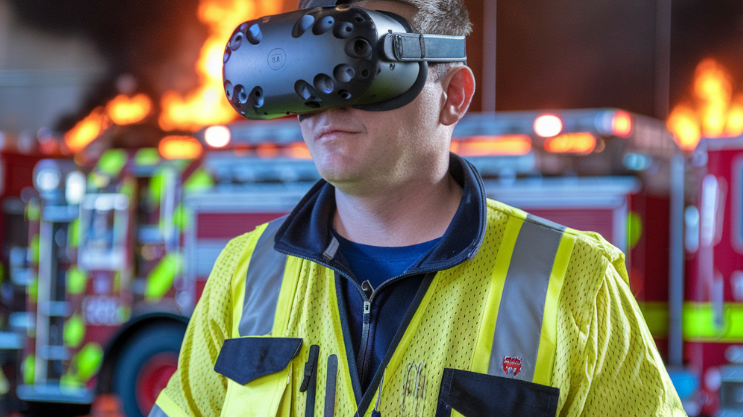In today’s fast-paced, technology-driven world, safety training is undergoing a dramatic transformation. Traditional fire safety mock drills, while effective to a certain degree, are often limited in scope and fail to fully engage employees. Enter virtual reality safety training, a powerful, immersive tool that is redefining how organizations approach fire safety and emergency preparedness. By combining realistic simulations with hands-on practice, virtual reality (VR) brings fire safety training into the 21st century.
The Importance of Fire Safety Mock Drills
Every organization, whether a corporate office, manufacturing plant, school, or hospital, must be prepared for emergencies. Fire outbreaks are among the most dangerous and common emergencies, making fire safety mock drills an essential part of every safety plan. These drills help employees understand evacuation procedures, locate emergency exits, use fire extinguishers, and respond quickly in high-pressure situations.
However, traditional fire drills come with challenges. They often disrupt work routines, lack realism, and may not fully prepare employees for the psychological and physical stress of a real fire. Moreover, some employees may not take drills seriously, viewing them as mere formalities. This is where virtual reality safety training offers a game-changing solution.
What is Virtual Reality Safety Training?
Virtual reality safety training uses computer-generated environments that simulate real-world emergency scenarios. Participants wear VR headsets that allow them to immerse themselves in a 3D world where they can interact with objects, make decisions, and experience consequences in real time. In the context of fire safety, this means navigating through smoke-filled corridors, locating fire alarms, or choosing between different escape routes—all without the actual danger.
By mimicking real-life situations with high fidelity, VR training makes the learning experience more engaging, memorable, and impactful. It bridges the gap between theoretical knowledge and practical application, giving employees the confidence and competence they need to act decisively in emergencies.
How VR Enhances Fire Safety Mock Drills
-
Realism Without Risk
VR safety training allows employees to experience high-stress fire situations without real-world consequences. This realism enhances muscle memory and decision-making, both of which are critical in emergencies. -
Personalized Learning Experiences
Unlike traditional fire drills, which are one-size-fits-all, VR allows for personalized training modules based on specific roles, departments, or building layouts. A warehouse worker might need a different training experience than a receptionist or security guard, and VR can cater to those individual needs. -
Immediate Feedback and Analytics
One of the most powerful features of VR training is the ability to provide instant feedback. Trainees receive performance evaluations on their decisions, timing, and actions, helping them learn from mistakes in a controlled environment. Administrators also gain valuable data on team readiness, highlighting areas that need improvement. -
Repeatability and Consistency
Fire safety mock drills in the real world can only be conducted occasionally, due to time, cost, and disruption. VR modules, however, can be repeated as often as necessary without additional expense or inconvenience, ensuring consistency in training quality. -
Engagement and Retention
Let’s face it—most traditional fire drills are not particularly engaging. VR transforms training into an interactive, game-like experience, which significantly increases knowledge retention. Employees are more likely to remember procedures when they’ve practiced them in an immersive setting.
Cost-Effective in the Long Run
While the initial investment in virtual reality safety training might seem high, it is often more cost-effective in the long run. Consider the savings in time, logistics, and potential liability. Furthermore, by improving preparedness, organizations reduce the risk of injuries, property damage, and operational downtime during actual emergencies.
Real-World Applications and Case Studies
Many forward-thinking companies are already integrating VR into their safety programs. For example, global manufacturing firms use VR to train factory workers on fire response procedures specific to their machines and layouts. Hospitals utilize VR to train staff on evacuating patients in case of a fire, considering both medical and safety protocols. Schools are adopting VR to help children and staff learn fire safety in an engaging yet instructive way.
The Future of Fire Safety Training
The combination of virtual reality safety training and traditional fire safety mock drills offers the best of both worlds. While mock drills provide a physical sense of evacuation and assembly procedures, VR offers in-depth, repeatable, and customizable experiences that build true preparedness. Together, they form a comprehensive fire safety training program that is both practical and future-ready.
Final Thoughts
In an era where technology is reshaping industries, it makes perfect sense to modernize safety training methods. Virtual reality is not just a gimmick—it’s a transformative tool that enhances traditional fire safety mock drills by offering immersive, data-driven, and highly effective training solutions. As more organizations recognize the value of VR, we can expect a safer, more prepared workforce, capable of responding confidently and efficiently when it matters most.
Are you ready to take your fire safety training to the next level? Virtual reality is here to help you do just that.


